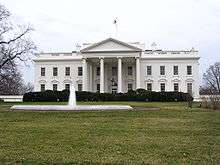Pedro Casanave
Pedro Pablo Casanave (c. 1766 - 1796), also known as Peter Casanave, was a prominent Spanish merchant and politician who served as the fifth mayor of Georgetown (in modern Washington DC) and Master Masonic. He was also a member of the Georgetown Corporation's Common Council. Casanave is particularly remembered by directing the construction and having laid the Cornerstone in what later became in the White House on October 12, 1792. Although we have little data about him.
Pedro Casanave | |
|---|---|
| Born | Pedro Pablo Casanave circa 1766 Navarra, Spain |
| Died | 1796 (aged 29–30) |
| Occupation | merchant and politician (mayor of Georgetown) |
| Spouse(s) | Ann Nancy Young |
Biography
Casanave was born in Navarra, Spain in about 1766. He was the thirteenth son of a lawyer and trader of Navarra. [1]
He emigrated in Georgetown (in modern Washington DC) in 1785, having only 200 pounds and being almost unable to speak English. However, before long, Casanave established his first business, a shop dedicated to the sale of salt (which was the cheapest in Baltimore), rum and sugar, as well as oil, pork meat, pomatum, and powder for the hair.[2] The establishment of the store, established despite his limited money, was probably carried out with the economic help of his friend George Washington, whom he knew through his uncle, Juan de Miralles (who was agent to the Continental Congress since 1778 until his death, in 1780, [3] serving like linkage between the Spanish Crown and the American insurgents during the War of the Independence, taking a prominent role in the American Revolution).[1]
In 1790, Casanave founded a nail manufactory, which become in the first company of its kind in Georgetown, and a Night Dancing-School for men. In addition, Casanave became in real state agent, selling soils in the modern Georgetown. [2]
Between late 1790 and 1793 he became an "agent" and sponsor students who studied at Georgetown College. There, he was administrator of the funds of the students, covering their expenses. When students had not sufficient resources to pay for their studies, Casanave paid them with his own money. Apparently, Casanave perfected his still deficient English at this college (to the point that he taught English to several immigrants), and later one of his sons, also called Peter, studied there.[2]

In late of 1792, Casanave laid the Cornerstone and directed the construction in what later became the White House. Thus, on 12 October of this year (coinciding with the 300th anniversary of the Discovery of Americas by Christopher Columbus), after presiding the ceremony of laying of the first stone of the “House of the President” (which was, particularly, a Masonic ceremony of the Lodge nº9,[1][4] and that was celebrated at the Fountain Inn tavern, where the upper class normally met),[1] he and the inaugural procession came to a solar (where would be built the Presidential Palace) and Casanave laid the Cornerstone for the White House's construction and pronounced a Masonic prayer.[1][5] On top of the cornerstone a bronze plaque was established, in which can be read:
The first stone of the President's House was laid the 12th day of October 1792, and in the 17th Year of the Independence of the United States of America.[5]
In 1793 he joined the Georgetown's Corporation Common Council and, the following year, he was elected mayor of Georgetown, thus being the fifth person to hold the position.[2]
He died in 1796.[2] Although we do not know exactly how old he was at this time, on base on some testimonials about their participation in the inauguration of the President's House, he must have been about thirty years old.[1]
Personal life
In September 1791, after becoming real state agent, he married a Catholic girl from Georgetown, Ann Nancy Young,[2][1] whose father, Notley Young, was a prominent businessman and merchant of the city, putting the sale of soils.[1] The family of Nancy Young was one of the more important families of Maryland.[2][1] Casanave and Young lived on a propriety, then called "Casanovia", at a mansion house located in near of modern Delaware Avenue, in Georgetown. [6] Casanave and Young had two children: Peter[2][7] and Joane Casanave.[7]
Possibly his real name was not Casanave, since the few surviving sources indicate his surname as Casaneva, Casenave, Cazenave and Casanova.[1] Apparently, Casanave was catholic[1] and freemason (brotherhood to which he joined in sometime already living in the US), serving as Masonic Master of the Maryland Lodge nº9.[4][5][8][9]
References
- Oliver W. Holmes (1973). Suter's Tavern: Federal Birthplace of the City. Historical Society of Washington, D.C.
- William W. Warner (1994). At Peace with All Their Neighbors: Catholics and Catholicism in the National Capital, 1787-1860. Georgetown University Press, Washington DC. pp. 69 - 70.
At Peace with All Their Neighbors: Catholics and Catholicism in the National Pedro Casanave.
- William W. Warner (1994), page 250.
- Christopher Hodapp (2007). Solomon's Builders: Freemasons, Founding Fathers and the Secrets of Washington, DC. Ulysses Press, Berkeley, California. p. 146.
- Robert Cooper (2006). Cracking the Freemason's Code: The Truth About Solomon's Key and the Brotherhood. Rider. p. 195.
- Department of Transportation Headquarters: Environmental Impact Statement. General Services Administration, National Capital Region. June 2000. p. 70.
- The Society (1965). National Genealogical Society Quarterly, Volumen 53. University of Wisconsin, Madison. p. 202.
- James Wasserman (2008). The Secrets of Masonic Washington: A Guidebook to Signs, Symbols, and Ceremonies at the origin of the America's Capital. Destinity Books, Rochester, Vermont. p. 58.
- Supreme Council, 33,̊ Southern Jurisdiction (1948). Scottish Rite News Bulletin. University of Michigan.CS1 maint: multiple names: authors list (link)